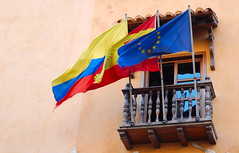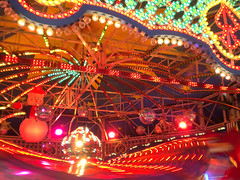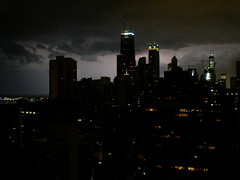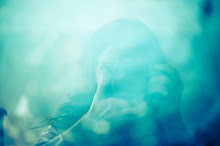shutter speed can be used in relation to the aperture if that is your priority; or it can be used as a tool to get the motion effects you desire. there are two basic types of motion effects: stop motion and motion blur.
 stop motion shows no blur; but because of the subject's orientation, you know it had to be in motion when the picture was taken (think person jumping in mid air or these flags flying). you obtain this effect when the shutter is open for a short period of time.
stop motion shows no blur; but because of the subject's orientation, you know it had to be in motion when the picture was taken (think person jumping in mid air or these flags flying). you obtain this effect when the shutter is open for a short period of time. motion blur is different from just a blurry photo. motion blur shows the subject blurry to indicate motion while the some reference surroundings are in focus (think fast moving car - it's blurry but the street surroundings are in focus). you obtain this effect when the shutter is open for a longer period of time and/or how close you are to the subject (think of driving past a trees right by the street and then trees at the horizon - trees on the street look blurry, trees on the horizon don't seem to move at all). you'll also often see shutter speed manipulation with water shots; a nice blurry white waterfall indicates a slow shutter speed.
motion blur is different from just a blurry photo. motion blur shows the subject blurry to indicate motion while the some reference surroundings are in focus (think fast moving car - it's blurry but the street surroundings are in focus). you obtain this effect when the shutter is open for a longer period of time and/or how close you are to the subject (think of driving past a trees right by the street and then trees at the horizon - trees on the street look blurry, trees on the horizon don't seem to move at all). you'll also often see shutter speed manipulation with water shots; a nice blurry white waterfall indicates a slow shutter speed. a plain old blurry photo is most likely due to the camera shutter being open too long plus small hand shakes. you may not think your hand is shaking, but your camera ain't no fool. a rule of thumb to reduce hand shake for photos taken without a tripod is to keep the shutter speed at least greater than the inverse of the lens focal length (50mm lens = at least 1/50sec shutter speed).
a plain old blurry photo is most likely due to the camera shutter being open too long plus small hand shakes. you may not think your hand is shaking, but your camera ain't no fool. a rule of thumb to reduce hand shake for photos taken without a tripod is to keep the shutter speed at least greater than the inverse of the lens focal length (50mm lens = at least 1/50sec shutter speed).(see the unintentional blur near the top of the buildings?)
this is a good time to get into shutter speed measurements. it is measured in seconds and fraction of seconds. the example above showed the photographer needed at least one-50th of a second shutter speed to reduce hand shake with a 50mm lens. shutters can stay open as much as 30" or as little as 1/1000sec or faster! digital cameras don't use the '1/' notation though; they would just indicate 50, 250, 1000.
another reason to leave the shutter open long enough would be in low-light situations where you need to gather in as much light as possible (think night landscape shots - no motion blur necessary; but it's still dark, so you need to take in as much light as possible).
the more light you need, the slower shutter speed you need. remember: because shutter speed and aperture are related, a change to one is a change to the other!
some good articles: ephotozine, digital photography school, wikipedia
next i'll get into ISO and the completion of the "exposure triangle."


No comments:
Post a Comment